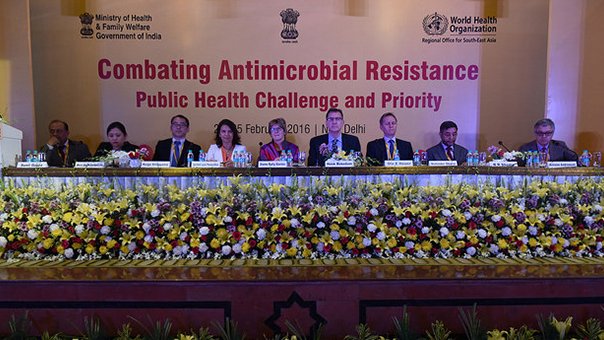Government of India and WHO host meeting of government, industry and public sector to tackle AMR
25 Feb 2016
Written by Tamar Ghosh
This week in New Delhi a further step was taken towards a new National Action Plan on antimicrobial resistance (AMR) by India. A national policy on tackling AMR has been in existence in India since 2011 and this week saw senior representatives from the Ministry of Health & Family Welfare, Government of India, join health ministers from across the region, and representatives from industry and civil society to discuss important aspects of this global problem. Attendees from the UK included Dame Sally Davies, Chief Medical Officer for England and Longitude Prize Advisory Panel Co-chair and Committee member, and Hala Audi of the Review on Antimicrobial Resistance.
Combating Antimicrobial Resistance: Public Health Challenge and Priority
New Delhi, India
23 – 25 February 2016
350 participants representing 16 countries joined this meeting in New Delhi to help further development of a National Action Plan, and to help India shape the development of its own roadmap towards this. We heard lessons from Thailand, Nepal, Japan, Myanmar and Indonesia as well as the United States, Sweden and the Netherlands on areas such as the rational use of antimicrobials, infection prevention and control, and surveillance in humans, animals and the environment. We also spoke about the Longitude Prize during one of the panel sessions. A call from WHO to participate in the Global Antimicrobial Surveillance System (GLASS) was received well, which will help us better understand the true global picture of drug resistant infections.
AMR is recognised as a matter of global importance. In 2015 the 68th World Health Assembly resolution adopted the Global Action Plan on AMR with member states committing to developing National Action Plans by 2017. Many countries have announced their Plans, including the UK. The potential economic and social impact of growing resistance on the world has been brought into stark focus by the Review on Antimicrobial Resistance led by Lord Jim O’Neill, commissioned by the UK Government in 2014 alongside the Wellcome Trust. This Review has helped us all understand the potential loss of life and economic impact of the current trajectory.
New campaign for public awareness of AMR
An area of important discussion was around steps to raise awareness and understanding of AMR across health professionals and the public. The Ministry of Health & Family Welfare unveiled new social media and radio advertising campaigns aimed at patients and pharmacists.
Be a responsible consumer of#ANTIBIOTICS . PIC.TWITTER.COM/C7XUCYCTSL
— Ministry of Health (@MOHFW_INDIA) 25 FEBRUARY 2016
Awareness was recognised as a complex issue, needing multiple stakeholder groups such as patients, consumers, health workers, government and civil society to work together.
We also recognised the added complexity posed by the availability of over-the-counter drugs in India, necessary in some rural areas. This presents a problem, but the fact remains that more lives are affected by lack of access to antibiotics, than by their excessive use. To overcome the access gap, commitments were made to strengthen collaboration amongst stakeholders. A One Health approach was also explored and supported, considering human and animal health alongside the environment, at national and subnational levels.

New ideas for AMR solutions
We had an opportunity to understand the current investment in AMR and related research. Much research is being carried out in India and beyond to better understand resistant bugs and whilst some research is showing reductions in resistance in certain cases of specific bacteria, there is also growing resistance in India and other countries to last line antibiotics, with evidence of complete drug resistance in some cases.
Innovation is playing an ever increasing role in tackling AMR. Across India some of the world’s leading engineering and science institutions are working on exciting new developments and examples of cross discipline approaches. I talked about the Longitude Prize as part of this call for innovative approaches: We have already seen 13 teams across India start to work on ideas, but we know there are many more teams to be formed and novel approaches to be taken.
A transformative, affordable, accurate and easy-to-use diagnostic tool that provides a result in 30 minutes could save lives when used in hospital settings, by health workers in primary health clinics, in pharmacies and potentially at home, and could also reduce the economic burden of overprescribing. It would help to take better care of existing antibiotics whilst helping to improve the use of new and accessible antibiotics.
Lessons and WHO support
At the end of the conference the priority areas for the National Action Plan were considered to be:
- Improving awareness and understanding of the issue
- Strengthening surveillance in human, animal and agricultural sectors
- Strengthening infection control practices
- Promoting the rational use of antimicrobials
- Promoting investments in AMR and related areas.
The National Action Plan would be owned across Ministries and sectors and should be supported by a nodal institution on AMR and the establishment of a multi-sectoral coordination body. WHO reinforced its commitment to support India and across the region through providing advocacy, capacity building and technical assistance, supporting resource mobilization and leveraging other resources.
Considering population size and infection prevalence, India is a complex environment for AMR. However, this makes the challenge ever more important to address. With so much support and passion across the sectors and incredible talent I hope that we see action in all aspects of development and innovation, including, I hope, some novel approaches to a diagnostic that could help us to better steward these crucial drugs.
